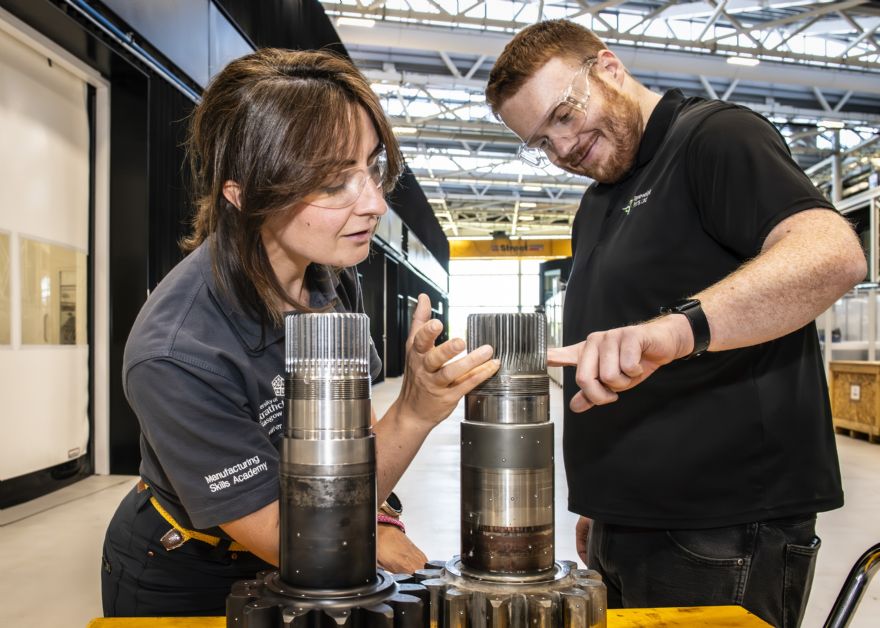
A research collaboration between
Renewable Parts Ltd (RPL),
SSE Renewables, and the
National Manufacturing Institute Scotland (NMIS) has demonstrated the potential to remanufacture critical onshore wind turbine components — restoring worn or damaged parts to their original specification or better – to drastically cut waste, reduce carbon emissions and extend part life.
Using advanced additive manufacturing (AM), analysis and inspection techniques, the team successfully restored damaged pinion shafts from a wind turbine yaw gearbox, a key component that keeps turbines facing into the wind to maximise energy capture. Pinion shaft failures frequently lead to the replacement of components, resulting in up to 42kg of steel being scrapped and causing turbines to go offline.
Early trials showed that remanufactured parts could perform to original specifications following machining and non-destructive testing, saving up to 84kg of CO
2 equivalent per remanufactured component. RPL is now looking to validate the units and compare with new shafts ahead of operational field trials. Building on the success with pinion shafts, there is also potential to explore remanufacturing other critical wind turbine components using similar advanced manufacturing technologies.
The longer-term ambition is to widely use remanufactured pinion shafts in wind turbines across UK windfarms, potentially saving thousands of tonnes of steel waste and significantly lowering emissions. With approximately 15.7GW of onshore wind capacity currently operational across the UK, the potential impact of adopting remanufactured pinion shafts at scale is substantial.
Ryan McCuaig, product development engineer at Renewable Parts, said: “Remanufacturing could be a gamechanger for improving sustainability in the wind sector and significantly increase the percentage of steel recirculated within our refurbished products portfolio. We have had the concept for some time but lacked the specialist facilities and expertise to take it forward. Working with NMIS and SSE Renewables has allowed us to prove that these critical components don’t need to end up in a skip - they can be given a second life.”
Circular manufacturing initiativeThe project is part of
ReMake Glasgow, a circular manufacturing initiative supporting companies in the region to adopt technologies for remanufacturing and refurbishment, with a focus on advancing circular innovation in energy, aerospace and transport. The aim is to cut CO
2 emissions by up to 99% compared to producing new parts at a time when fewer than 2% of UK products are designed to be reused.
Andreas Reimer, the Digital Factory’s senior Glasgow ReMake theme lead at NMIS, said: “Repair and remanufacture must become mainstream if we are to reduce the environmental impact of what we make and use, but also to present new economic and business model opportunities - particularly in high-integrity sectors, such as renewable energy. This work with Renewable Parts is a great example of how we can bring together innovation, expertise, and industry demand to develop new circular solutions that also support local supply chains.
“If adopted industrywide, remanufacturing could not only prevent vast amounts of steel waste but also substantially cut emissions linked to air miles by reducing the need to import replacement parts from overseas. Manufacturing parts locally would also create jobs and help retain specialist manufacturing skills within the UK.”
The project was funded in part by the Glasgow City Region Innovation Accelerator programme, led by
Innovate UK on behalf of
UK Research and Innovation. With a one-year extension now underway, ReMake Glasgow will continue supporting manufacturers to adopt circular practices and drive sustainable growth.
Last year, NMIS also launched the £5.5 million
ReMake Value Retention Centre (RVRC) with the universities of Strathclyde, Exeter and Sheffield. The RVRC is taking a multi-disciplinary approach to circular innovation, from advanced repair techniques to new business models, helping manufacturers extend product life and reduce emissions at scale.